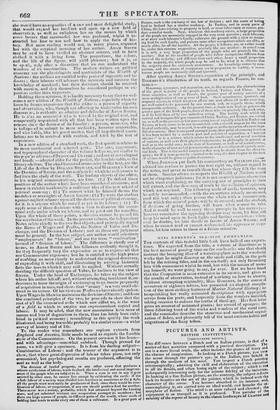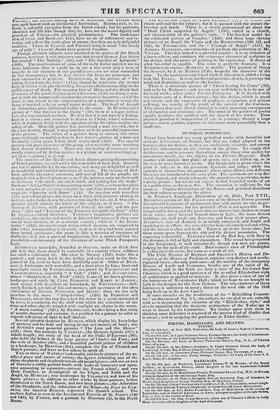PICTURES AND ARTISTS.
BRITISH INSTITUTION.
[CONCLUDING NOTICE.]
THE difference between a Dutch and an Italian picture, is that of a matter-of-fact narrative compared with a poetical description. The one is a mere literal truth, the other includes the graces of fancy and the charms of imagination. In looking at a Dutch picture, you vie! the scene through the painter's eye; in the Italian, you behold it through the medium of his mind. You inspect a Dutch painting microscopically ; admiring the skill and elaboration of the execution in all its details, and often losing sight of the subject ; which is not infrequently interesting only for the minute fidelity of the imitation. In looking at a fine Italian picture, on the contrary, the subject reflects back its beauties on the art of the painter, which is imbued with time character of the scene. You become absorbed in its interest, and, contemplating it, are earried into an ideal world, and breathe time at• mosphere of fiction. The mind is at once calmed and elevated ; the enjoyment is as tranquil as it is profound. You partake of the serenity of the repose of beauty in tke elassie landscapes of CLAUDE and THE difference between a Dutch and an Italian picture, is that of a matter-of-fact narrative compared with a poetical description. The one is a mere literal truth, the other includes the graces of fancy and the charms of imagination. In looking at a Dutch picture, you vie! the scene through the painter's eye; in the Italian, you behold it through the medium of his mind. You inspect a Dutch painting microscopically ; admiring the skill and elaboration of the execution in all its details, and often losing sight of the subject ; which is not infrequently interesting only for the minute fidelity of the imitation. In looking at a fine Italian picture, on the contrary, the subject reflects back its beauties on the art of the painter, which is imbued with time character of the scene. You become absorbed in its interest, and, contemplating it, are earried into an ideal world, and breathe time at• mosphere of fiction. The mind is at once calmed and elevated ; the enjoyment is as tranquil as it is profound. You partake of the serenity of the repose of beauty in tke elassie landscapes of CLAUDE and you spell. bound with an intellectual fascination. REMBRANDT, is, in- deed, a splendid exception from the Dutch school ; but his portraits,
identical and life like though they be, have not the morel dignity and grandeur of Terms—the physical! predominates. The landscapes
also of Cum and Born (see 114), have an air of refinement nod se- renity, and reflect the warm glow of nature; but they ore oily delightful realities. Those of CLAUDE and Poussm bring to mind " the lovely age of gold." CLAUDE should have painted Paradise. Though elevated subjects were unsuited to the genius of the Dutch painters, however, it lens slot every one that treaded them ns Jest STEIN has treated " The Nativity" (94), and " The Sacrifice of 1phigenia" (109). The anachronisms of some of the early Italian painters are no more ludicrous than it n ould be to see a tine actor play a hero of tragedy in tic costume of our grandfataers—we are soon reconciled to the incongruity ; but in JAN STEEN the faces are grotesque, and their expression is grimace. fl 1:31EltANDT, in his picture of " The taking down from the Cross " (115), though he represents the wasted body of Christ with ghastly fidelity, hasgivenrtdivinetranquillity to the
pallid aspect of death. The weeping face of Mary, and the Week look of sorrow of the youth leaning agaiust the cross, excite so strong a sym- putt y with the human suffering dart the costume is forgotten ; and it' the mina is not raised to the coutemplation of a superhuman event, the heart is touched es by an actual tragic incident. The bend of Joseph
of Arimathea gives additional reality to the scene. In REMIDIANDT'S
picture of " Our Saviour in the Storm " (73). there is a happy indica- tion of a supernatural incident. ‘Ve feel that it is not merely a fishing- boat in a storm ; our attention is drawn to Christ, whose calmness, while it contrasts finely with the agitation of the Disciples, implies the safety of all. Here the painter has introduced a man see-sick, but it does not destroy, though it may interkre wilh the powerful impression of the picture. The virtue of a painter being in earliest, was never more strikingly exemplified than in JAN STEIN'S picture of a boor and
his family saying grace before their scanty meal (130). The squalid poverty and gross character of the group serve to render more touching their devout thankfuluess. Never was the feeling of reverence more vividly expressed by Italian pinto. in u picture of saint-worshipping: yet there is grimace in it, too.
The contents of the Middle and South Rooms, principally consisting of Dutch pictures, we will notice the remainder of them first. Scarcely one but is admirable fur its execution ; and ninny are delightful as well as wonderful and truthful imitations of meek. The scenery of Hol- land, and the character, costumes, and way of life of the people, are depicted with a literal minuteness, as if the paintet s were on their oath to delineate "the truth, the whole truth, and nothing but the truth." Such are "Adrian Ostade in his painting-room " (70),—as homely a place as ever miracles of air were wrought in, and from whence issued this
exquisite " Interior with Boors" (55). An inn-door with travellers (71 ), and a frost piece—the scene on a river, with peasants skating to
market, and a sledge drawn by a horse crossing the ice—by J. 0st-ens:— pictures which contain the whole of the subject, as it were. " The chateau of Teniers, with portraits of himself, his wife, and his gar- dener" (62) and .‘ Interior of the Emperor Leopold's Gallery" (74),
by 'ft:vit.:Its—literal identities. Texintis's imaginative pictures are anomalies; the gipsies and monks in 165 and 168 seem as if they were
out of their element, or in a strange country • while in " An Incan-
tation" (112), the nondescript forms which demons are supposed to take when masquerading, it on earth, look as if they bad been painted
from actual specimens : the scene is like a museum of creatures of diablerie ; it is not a piece of imagination, but a matter-of-fact im- possibility—an inventory of the furniture of some Dutch Prospero's brain.
RUYSDAEL'S waterfalls, beautiful as they are, make us think how odd it is that there should be waterfalls in a country whose wildness Las such a cultivated air. His view in Norway (172), looks like a portrait ; and every brick in the bridge and every weed in the fore- ground of 75, seem to have been faithfully copied. Other of RUTS- DAEL'S landscapes with waterfalls, and a frost piece by him ; frost and moonlight scenes by VANDERNEER ; sea-pieces by VANDEVELDE and VANDERCAPELLA, especially " A Gale" (142); and BACK UUYSEN, whose " Shipwreck of St. Paul " (167), is one of his finest pictures; landscapes and cattle by CUYP, BEIWIIEM, and KAREL 130 JARDIN ; road scenes with travellers on horseback, by WOUVERMANS — deli- cately finished, yet kill of life and motion ; and specimens of the ultra elaboration of Alisitts, Nut-suite, and Murzo: these we can only mention in the mass. " Stag-hunting" (120), by BEacttest and Ilacuaeta, where the stag has taken the water in a pond surrounded by trees, is a curiosity, for the skill with which the reflections of the trees and other objects mingled with sunlight are shown in the water. " A monk reading" (121), by REMBRANDT, besides being a fine study of ascetic character and costume, is a problem for a painter to solve as regards reflections of light in half shadow. Several splendid sketches by RUBENS. which display his knowledge of anatomy and his bold and daring design and mastery of hand ; one of SNYDER'S most powerful pictures " The Lion and the Mouse" (C2); three fine portraits by VANDYKE—the Marquis Spinola (87), a whole-length ; the study of the head of the Duke D'Epernon (99), who holds the helmet in the large picture of Charles the First; and the wife of Suyders (60); and a beautiful portrait picture of children in a landscape, by BRAUWER (164), complete the list of Flemish and Dutch pictures, and leave us few others to speak of. Two or three of IVarreat's admirable and lively pictures of the ar- tificial grace and nature of society, the figures reminding one of the china shepherds and shepherdesses on old mantelpieces—and one or two of GREUZE'S coldly-painted heads, with looks of innocence and open- ness amounting to vacancyre—present the French school • and two Holy Families, an Assumption of the Virgin, and Tobit and the Angel, by MURILLO • two landscapes by VELASQUEZ, and two of his figure pictures, in addition to other works by these painters, before mentioned in the North Room, and two large pictures—the Adoration of the Shepherds, and the Adoration of the Kings—by JUAN DE CAR. RENO, the Spanish RUBENS, represent the Spanish school. The modern Italian is seen in the Interior and Exterior of St. Peter's (149 and 149), by PANINI, and a portrait by Massimo (2), in the North Room. lie t t,i1N Mill 5. 111■141 01 ► 4501. LawA k
chaste and cool for the subject ; but it is painted with the utmost ela-
boration and finish. 'There is it stately processional air about the " Dead Christ supported by Angels" (158), suited to a church, and characteristic of the painter's style. " The finished model for the celetnated picture of Paradise" (166), and three large sketchy pictures of an Angel, the Virgin and the Resurrection (130. 131, and 1:32), by TINTORETTO, and the " Triumph of Scipio" (157), by ANDREA ANTEGNA, are curiosities of art frem the collection of Mr. V/VYAN. This last indeed is a pictorial wonder: it is till imitation of a basso. relieves, and combines the statuesque ammeter of sculpture in the design. with the power of painting in the expression. It shows of a bat has.relief is capable. The scene is pet lectly dramatic. It is EURIPIDES on PanYnS—RAPDAEL in marble. The portrait of Henry the Seventh, by J. DE N1ABUSE (156), bespeaks the character of the man. To the quaintness mid literal truth of 110LBEIN is added a living look like TITIAN. It is an intellectual portrait—that is, it portrays the mind and disposition as well as the features. There is a miniature picture of " Christ bearing his Cross" (79), said to lie by RAPHAEL ; and we dm very well believe it to be one of his early works, when tinder l'irrno Ptatuoneo. It is finished with the minute care of a Dutch pietitre; but the design, which is grand and simple, and the expression of goodness, resignation, and patient suffering, tile worthy of the youth of the painter of the Cxegrttowonnes; mere shows that e literal imitation is not a necessary consequence of elaboration and miniature size. The mind of the primer of genius equally irradiates the smallest and the largest of his works. Even physical grandeur is independent of size in /gamin; though a large !picture, eateris paribus, imposes on the senses more puwerfully than a small one.



























 Previous page
Previous page